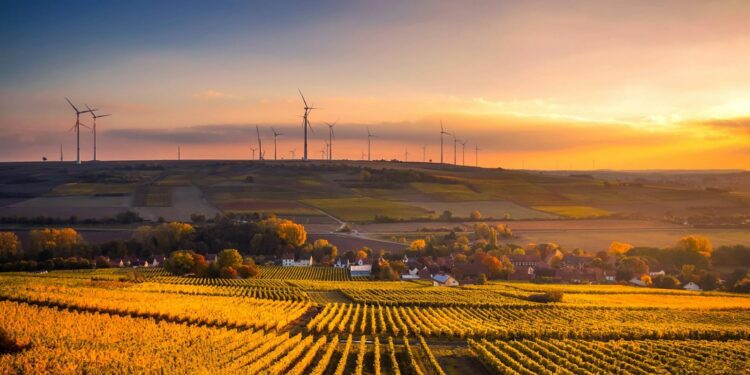In today’s world, sustainability isn’t just a buzzword—it’s a powerful movement driving economic opportunity, environmental stewardship, and social good. As the global demand for clean energy skyrockets, renewable energy projects like wind farms, solar farms, and battery energy storage systems (BESS) are transforming the landscape of business development. For landowners, entrepreneurs, and aspiring brokers, these projects offer a unique chance to generate significant income while contributing to a greener planet. This guide dives deep into how you can make money by leasing land for wind power, battery storage, and solar farms, or by acting as a broker in this booming industry. Let’s explore the opportunities, practical steps, and inspiring potential of this sustainable business model.
The Rise of Renewable Energy: A Win-Win for Profit and Planet
The renewable energy sector is experiencing unprecedented growth. According to Deloitte, solar energy surpassed hydropower and nuclear as the fourth-largest source of installed capacity in the U.S. in 2024, with an expected addition of 38.4 GW of solar capacity and 14.9 GW of battery storage by the end of the year. Wind power, contributing over 10% of U.S. energy in 2022, continues to expand, with 153.8 GW of capacity projected by 2025. The global renewable energy market, valued at $1.21 trillion in 2023, is expected to grow at a 17.2% annual rate through 2030. This surge is fueled by declining costs of solar and wind technologies, supportive policies like the U.S. Energy Act of 2020, and increasing corporate demand for clean energy to power data centers and operations.
For landowners and entrepreneurs, this creates a golden opportunity. By leasing land for renewable energy projects, you can secure long-term, stable income while supporting the transition to a net-zero future. Acting as a broker—connecting landowners with developers—offers another lucrative path, leveraging negotiation skills and market knowledge to earn commissions. Below, we’ll break down each avenue, including practical steps, financial potential, and key considerations.
Leasing Land for Renewable Energy: A Lucrative Opportunity
Leasing land for wind farms, solar farms, or battery storage is one of the most accessible ways to enter the renewable energy market. Here’s how each type of project works and what landowners can expect.
1. Solar Farms: Harnessing the Power of the Sun
What Are Solar Farms?Solar farms are large-scale installations of photovoltaic (PV) panels that convert sunlight into electricity. They typically require 5–10 acres per megawatt (MW) of energy produced, with projects ranging from 1 MW to over 120 MW. A 5 MW solar farm, for example, can power approximately 1,000 homes and requires about 25–50 acres of land.
Financial Potential
- Rental Income: Lease payments for solar farms typically range from $300 to $2,000 per acre annually, depending on location, grid proximity, and project size. For a 40-acre solar farm, this could translate to $12,000–$80,000 per year. Over a 30-year lease, a landowner could earn $1.2 million or more, with some leases including escalators (e.g., 2% annual increase) or revenue-sharing (4–6% of project revenue). For instance, a 5% revenue share on a high-performing site could yield $1,400–$1,500 per acre annually in some markets.
- Bonuses: Developers often pay upfront bonuses, such as $500–$1,000 per acre upon signing a lease option and another $1,000 per acre when the lease is executed. A 40-acre parcel could net $60,000 in bonuses alone.
- Tax Benefits: In some regions, leasing land for solar can reduce or eliminate property taxes, as developers like YSG Solar negotiate tax agreements with local authorities. Certain states, like Michigan, offer tax breaks for preserving land as open space.
Key Considerations
- Land Suitability: Ideal solar farm sites are flat or gently sloped (less than 10 degrees), south-facing, and free of tall trees or heavy vegetation. Proximity to a substation (within 2 miles) and three-phase power lines (within 1,000 feet) is critical for cost-effective grid connection. Locations in sunny regions, like the southern UK or U.S. Southwest, maximize energy output.
- Zoning and Permitting: Land zoned for industrial or agricultural use is typically eligible, though some areas (e.g., Long Island’s Brookhaven) restrict solar development to industrial parcels. Developers like YSG Solar may assist with rezoning or navigating local regulations.
- Dual-Use Opportunities: Solar farms can coexist with agriculture. Sheep or poultry can graze beneath panels, and developers often seed wildflowers to attract pollinators, boosting biodiversity. For example, AES’s Grafton solar project integrates agrivoltaics, combining solar generation with crop or livestock production.
- Environmental and Community Impact: Solar farms have low visual and noise impacts compared to wind turbines. They’re often screened with fencing or hedges and can enhance local biodiversity. However, community resistance may arise due to concerns about landscape aesthetics or reduced farmland. Engaging communities early, as recommended by Conrad Energy, can improve project approval odds.
- Lease Terms: Leases typically last 25–50 years, with options for extensions. Landowners should negotiate decommissioning clauses to ensure the land is restored post-project, often backed by a bond to cover costs.
Case Study: At Larport Solar Farm in the UK, 125 acres generate 44,000 MWh annually, with a biodiversity net gain of 132% through tree planting and pollinator-friendly meadows. The landowner earns approximately £1,000 per acre annually, index-linked for 40 years, providing stable income while supporting sustainability.
2. Wind Farms: Capturing Energy from the Air
What Are Wind Farms?Wind farms consist of multiple turbines that convert wind energy into electricity. They require less land per turbine (1–2 acres) than solar farms, as farming can continue around turbine bases. Ideal sites have consistent, strong winds and are often located in rural or coastal areas.
Financial Potential
- Rental Income: Wind farm leases typically pay $4,000–$8,000 per turbine annually, with some landowners earning $10,000 or more per turbine depending on project size and location. A 10-turbine wind farm on 20 acres could generate $40,000–$80,000 per year. Leases often span 25–30 years, with escalators or revenue-sharing options.
- Economic Benefits: Wind projects contribute $2 billion annually in U.S. state and local tax payments and land-lease payments, supporting schools and infrastructure. A Michigan study found that community solar and wind projects could create $1.47 billion in economic impact and 18,500 jobs over 30 years.
- Additional Revenue: Landowners can continue farming or grazing livestock around turbines, maintaining agricultural income alongside lease payments.
Key Considerations
- Land Suitability: Wind farms require sites with high wind speeds, often in remote or elevated areas. Proximity to grid infrastructure is essential, though developers may run cables up to 10 miles for large projects. Environmental studies assess impacts on wildlife, particularly birds and bats.
- Visual and Noise Impacts: Turbines are taller and more visible than solar panels, and their blades produce noise, which can spark community opposition. Proper siting and community engagement are crucial.
- Lease Terms: Similar to solar, wind leases are long-term (25–50 years). Landowners should ensure contracts include restoration clauses and address liability for turbine-related damage (e.g., to livestock).
- Case Study: The London Array offshore wind farm saves 1 million tons of CO2 equivalent annually and supports SDGs like economic growth and climate action. Onshore, landowners like Jim O. in Arizona lease land for wind turbines while running cattle, securing stable income to pass down to future generations.
3. Battery Energy Storage Systems (BESS): Powering the Future
What Are BESS?Battery storage systems store excess energy from solar or wind farms, releasing it during peak demand or low generation periods. They typically occupy standardized containers on small parcels (1–5 acres) and are critical for grid stability as renewable energy grows.
Financial Potential
- Rental Income: BESS leases can pay $1,000–$2,500 per acre annually, depending on location and grid access. A 2-acre BESS site could generate $2,000–$5,000 per year, with leases lasting 20–30 years. Some developers offer revenue-sharing models tied to energy arbitrage or grid services.
- Market Growth: Battery storage capacity in the U.S. rose 64% to 7.4 GW in 2024, with 14.9 GW expected by 2025. The UK aims for 35 GW by 2050, creating significant demand for BESS sites.
- Low Land Impact: BESS requires minimal land, making it ideal for smaller or irregularly shaped parcels near substations.
Key Considerations
- Land Suitability: BESS sites need flat land near grid infrastructure (33kV or higher). Noise from cooling systems may require soundproofing if near residential areas.
- Environmental Impact: BESS can improve biodiversity by seeding non-hardstanding areas with native plants. Developers like Centrica Business Solutions minimize visual impacts with fencing or hedging.
- Regulatory Hurdles: BESS projects face fewer zoning restrictions than solar or wind farms but require rigorous safety and environmental assessments due to fire or toxicity risks.
- Case Study: Anesco, a UK leader in battery storage, has connected over 30% of the UK’s BESS capacity. Landowners leasing for BESS benefit from stable rents while supporting grid resilience.
Becoming a Renewable Energy Broker: Connecting Land and Opportunity
For those without land, brokering deals between landowners and renewable energy developers offers a dynamic way to profit in this sector. Brokers act as intermediaries, identifying suitable land, negotiating leases, and facilitating project development.
How to Become a Renewable Energy Broker
- Understand the Market:
- Research renewable energy trends, policies, and key players (e.g., NextEra Energy, Lightsource bp, AES). Familiarize yourself with land requirements, grid connection processes, and local zoning laws.
- Stay updated on incentives like the U.S. Energy Act of 2020 or UK net-zero policies, which drive demand for renewable projects.
- Build a Network:
- Connect with landowners, particularly farmers or owners of large rural parcels, through agricultural associations, land trusts, or platforms like LandGate.
- Partner with developers, utilities, and consultants. Attend events like the Solar + Wind Finance & Investment summit (March 16–19, 2025, Phoenix, AZ) to build relationships.
- Develop Expertise:
- Learn about site assessment criteria (e.g., solar radiation, wind speed, grid proximity). Tools like LandGate’s Property Report provide free estimates of land’s renewable energy potential.
- Understand legal and financial aspects of leases, including option agreements, revenue-sharing models, and decommissioning clauses. Consult resources like the National Agricultural Law Center’s Farmland Owner’s Guide to Solar Leasing.
- Market Your Services:
- Create a website or leverage platforms like PositivePhil.com to showcase success stories and attract clients. Highlight your role in driving sustainability and economic growth.
- Offer value-added services, such as feasibility studies or community engagement plans, to differentiate yourself from speculative brokers.
- Negotiate and Close Deals:
- Identify high-potential land and pitch it to developers. Negotiate lease terms that maximize landowner returns while ensuring project viability.
- Earn commissions (typically 5–10% of lease value) or fees for facilitating deals. For a $1.2 million solar lease over 30 years, a 5% commission could yield $60,000.
Financial Potential
- Commissions: Brokers can earn $30,000–$100,000 per deal, depending on project size and lease value. High-demand regions like the U.S. Southwest or UK’s southern counties offer more opportunities.
- Scalability: By brokering multiple deals annually, experienced brokers can build a six-figure income. Diversifying into wind, solar, and BESS projects increases revenue streams.
- Consulting Opportunities: Offer services like site analysis or regulatory navigation for additional fees, especially for complex projects requiring rezoning or environmental permits.
Challenges and Tips
- Avoid Speculative Practices: Some brokers attract landowners with inflated offers, then sell development rights without project expertise. Partner with reputable developers like Q ENERGY or Low Carbon to ensure projects are completed.
- Build Trust: Landowners may be wary of “middlemen.” Emphasize transparency, provide data-driven valuations, and highlight your commitment to sustainability.
- Stay Informed: Renewable energy regulations and technologies evolve rapidly. Subscribe to industry reports (e.g., Deloitte Insights) and follow companies like Masdar or JERA Nex for updates.
Case Study: Success in Brokering
Victor, a renewable energy professional in Denmark, transitioned from offshore wind to brokering solar and wind leases. After joining Anesco in 2024, he leveraged his expertise to connect landowners with developers, facilitating 100+ projects across the UK and Ireland. His multidisciplinary approach—combining grid engineering, community engagement, and deal negotiation—earned him a reputation as a trusted broker, generating substantial commissions while advancing clean energy.
Key Considerations for Success
Whether leasing land or brokering deals, success in renewable energy requires careful planning and strategic execution. Here are critical factors to consider:
- Site Selection and Feasibility:
- Use tools like the Global Solar Atlas or wind resource maps to assess site suitability. Engage developers like Centrica Business Solutions to evaluate grid capacity and connection costs.
- Avoid protected areas (e.g., national parks, AONBs) where permits are unlikely to be granted.
- Legal and Financial Due Diligence:
- Consult attorneys to draft robust lease agreements, covering decommissioning, liability, and escalators. The heads of terms (initial agreement) are critical, as they set the framework for the lease.
- Understand tax implications and incentives. In the U.S., federal tax credits and state programs can enhance project profitability.
- Community Engagement:
- Address local concerns about aesthetics, noise, or land use early in the process. Developers like Lightsource bp prioritize community dialogue to secure planning approvals.
- Highlight benefits like job creation, tax revenue, and biodiversity gains to win community support.
- Sustainability and Dual-Use:
- Embrace dual-use models like agrivoltaics or grazing to maximize land productivity. Low Carbon’s solar parks, for example, support sheep grazing and pollinator habitats.
- Ensure projects align with sustainability goals, such as the UN’s SDGs, to enhance their appeal to developers and investors.
- Long-Term Commitment:
- Renewable energy leases are long-term (25–50 years). Consider family or estate planning implications, as income can benefit future generations.
- Negotiate flexible terms to accommodate changes in technology or land use needs post-lease.
The Positive Impact: Building Wealth and a Better Future
Leasing land for renewable energy or brokering deals isn’t just about profit—it’s about creating a legacy of positive impact. By participating in the clean energy revolution, you’re:
- Reducing Carbon Emissions: Projects like the London Array save millions of tons of CO2 annually, combating climate change.
- Supporting Communities: Lease payments and taxes fund schools, infrastructure, and local economies, as seen in Michigan’s community solar initiatives.
- Preserving Land: Solar and wind farms can restore soil health and biodiversity, ensuring land remains viable for future agricultural use.
- Driving Economic Growth: The renewable energy sector supports 125,000 wind jobs and growing solar employment, fostering economic resilience.
For landowners like Gerald and Joy Cooper, leasing land to Lightsource bp ensured financial stability for their 100-year-old family farm while preserving their connection to the land. For brokers like Victor, facilitating renewable projects creates wealth and advances global sustainability goals.
Getting Started: Actionable Steps
- For Landowners:
- Assess your land’s suitability using free tools like LandGate’s Property Report or consult developers like YSG Solar or Low Carbon.
- Contact local utilities or grid operators to confirm connection feasibility.
- Engage a lawyer to review lease agreements and negotiate favorable terms.
- Reach out to developers via their websites (e.g., development@lowcarbon.com) or industry platforms.
- For Aspiring Brokers:
- Enroll in renewable energy courses (e.g., Coursera, edX) to build technical knowledge.
- Join industry associations like the Solar Energy Industries Association (SEIA) or attend events like Infocast’s Solar + Wind Finance & Investment summit.
- Build a portfolio of successful deals by starting small, focusing on high-potential regions like California or Texas.
- Market your services through a blog, social media, or platforms like PositivePhil.com to inspire others.
- Stay Positive and Persistent:
- The renewable energy sector rewards patience and vision. Projects can take 1–6 years to develop, but the long-term payoff is substantial.
- Embrace the opportunity to make a difference while building wealth. As PositivePhil.com emphasizes, positivity and purpose drive success.
Conclusion: A Bright Future Awaits
The world of sustainability and business development is brimming with opportunity. By leasing land for wind farms, solar farms, or battery storage, or by brokering deals between landowners and developers, you can tap into a multi-trillion-dollar industry while advancing the fight against climate change. With long-term leases offering stable income, dual-use models preserving agricultural value, and brokering providing scalable profits, the renewable energy sector is a win-win for entrepreneurs and the planet. Take the first step today—assess your land, build your network, or share your journey on PositivePhil.com to inspire others. Together, we can power a sustainable, prosperous future.
Sources:
- Deloitte 2025 Renewable Energy Industry Outlook
- YSG Solar: Leasing Land for Solar and Battery Storage
- Anesco: Landowner Partnerships
- Centrica Business Solutions: Leasing Land for Energy Storage
- LandGate: How to Make Money Leasing Land for Solar
- AES: Partnering with Communities
- Lightsource bp: Land Leasing for Renewable Energy
- Department of Energy: Advantages of Wind Energy
- Farmers Weekly: Leasing Land for Solar


















